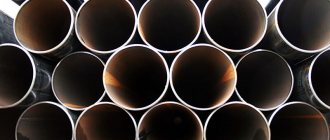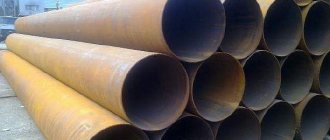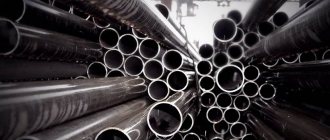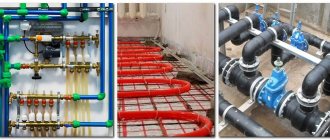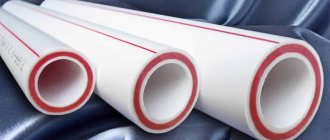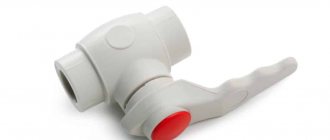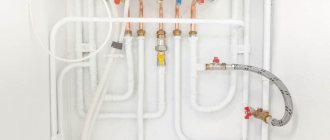Today, traditional concrete wells are increasingly being replaced by plastic structures. They are quite simple to construct, and operation is not associated with the common difficulties inherent in conventional concrete structures.
The main one for them is a corrugated pipe. It is made from polyvinyl chloride. Typically, pipes are made with a diameter of 31 to 60 cm. Thanks to the presence of stiffeners, the reliability of the structure as a whole is significantly increased. A plastic well for drinking water is an excellent solution if you need to create a reliable and durable structure. Modern material is increasingly used instead of reinforced concrete rings.
Advantages
Modern plastic wells are made from corrugated pipes for a reason. It is with this design of these products that they can easily withstand high loads that are transferred to them from the ground. Such structures for water intake can be made seamless or prefabricated. Geotextile fabric is usually used to filter water. It must be wrapped in two layers.
The main advantage of such models is their tightness. This is especially true for seamless wells. However, when using original technology for joining various elements, very good performance can be achieved in the case of prefabricated products. The fragments are connected using rubber seals.
Advantages of corrugated structures:
- You don't need to spend a lot of money to install the system. Installation is easy to do yourself.
- Due to the fact that the structure of the well elements is corrugated, the structure does not need to be strengthened.
- Due to the low weight of the elements, there is no need to use heavy equipment during the construction of the well. No special vehicles will be needed.
- Good strength indicators are ensured due to the material’s resistance to various external influences.
- Such products can be used in a wide temperature range. Moreover, such wells can be installed in different climatic zones.
- The low cost of finished structures makes corrugated rings affordable.
Important!
The material does not absorb moisture. This ensures a good service life of the well. The same cannot be said about traditional concrete structures. They have a limited number of freeze/thaw cycles. Then the process of destruction of the material begins.
Ideal alternative to concrete rings
Until recently, reinforced concrete rings were used to construct drainage wells. This material also perfectly withstands physical stress and is capable of long-term use.
But the plastic well for drainage is gradually replacing this traditional method. And all thanks to its qualities.
You cannot work with concrete rings yourself. Proper installation will require the use of special construction equipment, which is simply impossible in some areas. Concrete ring joints are quite difficult to make waterproof.
This may require high-quality cement mortar with the addition of liquid glass. In addition, the concrete must be coated with bitumen mastic both outside and inside. This will bring the well made of reinforced concrete rings closer to the desired tightness.
All this work will not be required if you use plastic products for storm drainage. The speed of work, quality and long-term operation make polymer wells an ideal solution to the problems of constructing drainage systems.
terms of Use
When installing a plastic well for drinking water, you should take into account the climate in the region. It is recommended to deepen the well no more than 6 m. Backfilling is done using sand or gravel.
Other features of the installation of plastic wells should be taken into account:
- In the area where it will be installed, seismic activity should not exceed 7 points.
- It is better not to install a plastic well if it will be operated at air temperatures below -50 degrees.
- Such structures can be placed in both wet and dry soils.
Important! The composition of the soil and other factors do not have a significant impact on the installation features of plastic corrugated products. They can be placed in soil of high flowability or with a high content of stones. These positive properties ensure the popularity of plastic structures.
Use of one-piece structures
The use of solid structures can significantly speed up the work on storm sewer construction. These include the KND drainage well , which is completely ready for use. A special feature of these products is their exceptional tightness. It is different from any cast product. Solid wells are manufactured with different heights and diameters. Therefore, choosing the necessary product will not be difficult.
Sewage pump for pumping out sewerage. - there is more useful information here.
A cover is supplied with the one-piece drainage well. This product has reinforced walls, supplemented with special stiffening ribs. All this allows the structure to withstand heavy loads that occur in the ground during the changing seasons and winter heaving.
The assembly of composite plastic structures takes much more time than the installation of a finished well.
This is an advantage of solid products, which is used by owners of country houses. The only obstacle may be cost. But all other benefits outweigh this minus.
You will be interested in this article - Bacteria for septic tanks and cesspools.
Selection of tools and materials
To prepare the pit and install the plastic elements correctly, you will need to prepare some tools and materials:
- Shovel – it will be needed for excavation work.
- Drill - this tool is used to make holes to introduce water into the structure.
- Geotextile fabric. It allows you to filter water.
- The base of the well is made of plastic seamless pipe.
- Wire – it will be needed to fix the geotextile fabric.
After preparing all the tools and materials, you can begin the main work. The well installation procedure has several subtleties. It is important for every land owner to know them. This information will also be useful when equipping the upper part of the well.
Which is better: prefabricated vs monolithic?
A prefabricated drainage well is assembled from various plastic parts, like a construction set. The monolithic product is already ready for installation; it just needs to be lowered into the hole dug for this.
Before purchasing a monoblock well, you need to carefully calculate everything; replacing part of it or extending the shaft after installation will not work
Monolithic options are cheaper and stronger than their prefabricated counterparts. However, they are produced in a rather narrow range of standard sizes. They are installed only to the depth specified in the instructions.
Individual elements of a prefabricated structure are easier to transport and load into a car than a large monoblock product. But in terms of compressive strength, even when assembled, they are inferior to an initially solid well. A solid body, by definition, is capable of withstanding large hydrodynamic and mechanical loads.
To extend the body, the prefabricated well can be equipped with several shaft rings in the middle part and an additional telescopic extension under the hatch (+)
Assembling plastic parts of a well for drainage involves the need to seal their joints. And each such joint is a potential hole and leak.
Plus, to tighten the elements you will need bolts and nuts. They should come together. If they are not available, then you should only buy galvanized fasteners, which are less susceptible to corrosion.
Main works
The installation instructions for a plastic well provide for the installation of a one-piece seamless pipe. Using the same technology, a well is constructed, assembled from different elements. However, in this case, the individual elements are connected to each other with convenient locks.
Advice! Sealing can be ensured by installing a rubber seal. The rubber must be of high quality. Otherwise, it may “harden” when the temperature drops or cannot withstand mechanical pressure.
The sequence of basic work when constructing a well is quite simple:
- First you need to prepare a two-layer pipe made of polymer material with a diameter of 40-60 cm. This product is intended for use in various soils.
- Then you should find the aquifer. Usually, various studies are carried out for this purpose. You can resort to the method of dowsing or exploratory drilling.
- When the water intake location has been found, it is necessary to begin digging a pit. Its diameter should exceed the diameter of the prepared pipe by 10-20 cm. This is necessary for ease of installation. Digging a hole for a well should be done continuously, without dividing the process into several stages. Thanks to this condition, the possibility of sticking of the column is eliminated.
- Digging continues until water appears.
- Then you need to prepare a plastic insert to properly equip the well. Perforation is performed from below between the ribs using a 7 mm drill.
- The pipe hole and the perforated area are covered with geotextile fabric. It is secured with a wire that has a protective sheath.
- When the installation of the plastic pipe is completed, the space between it and the edges of the pit is filled with sand. The top of the well is insulated.
- A submersible pump must be lowered into the well to pump out water. This must be done until the water becomes clear. It is necessary to place quartz sand into the lumen of the pipe. It will provide mechanical cleaning.
Attention! If you need to repair a concrete well, you can simply insert a plastic pipe into it. This eliminates labor-intensive operations to reconstruct the old source.
How to build an Abyssinian well
An Abyssinian well or Abyssinian well is a thin channel in the soil, for the construction of which the ground is pierced to a depth of 10 m. This channel is then formed using a pipe for a drinking well with a diameter of up to 1.5 inches. The well bottom is covered with marble chips. Due to its weak strength properties, a plastic pipe cannot be used to pierce the soil, so it is assigned exclusively a transporting function. Holes in the ground can be made with a garden auger, using collapsible rods to reach the aquifer.
The pipe is cut into pieces 1-2 m long: with their help, a hole in the ground is constructed using the extension method. It is very important that the pipe connections are as reliable as possible to avoid damage to the structure. In order for the pipe to move along the channel without delay, a filter needle is placed on its tip (it will also help clean the incoming water from all kinds of debris, and thus the source will not be flooded). When water appears in the well, deepening work stops and the flushing process begins. As a rule, self-purification of water occurs within 24 hours, after which it can be safely used for household and food purposes.
Abyssinian wells have the following advantages:
- Good service life.
- Ability to supply excellent quality water. The self-priming pump and the small cross-section of the well make it much more difficult for various impurities, debris and bacteria to penetrate into the well.
- Small capital investments during arrangement.
Types of plastic
Corrugated pipes for wells are made from different materials. They are usually based on natural or synthetic compounds. They are exposed to high heat. As a result, the materials become liquid. After cooling they take on their final shape. The beneficial properties of different materials are determined by the peculiarities of their manufacturing technology. They are cast at different temperatures and environmental conditions.
Among the majority of materials used, the following should be highlighted:
- Polyvinyl chloride. It is a thermoplastic polymer that is highly resistant to chemicals. The material is difficult to ignite in open spaces. However, plastic water meter wells are often made from PVC, which require increased protection from environmental influences.
- Polyethylene. It is a popular ethylene polymer. Products made from it have high density. The material is not exposed to aggressive environments, it is not able to react with various alkalis and salts.
- Polypropylene. This material is formed by the polymerization of propylene in the presence of catalysts. This material has high melting temperature characteristics compared to polyethylene. All products made from it can withstand boiling and steam sterilization.
Such materials are widely used in the creation of plastic wells. The large number of useful properties of such materials ensures their popularity. This is why plastic is being used more and more. It is used not only for constructing water wells, but also for sewer lines. Plastic products are ideal for water supply.
Construction of a well made of plastic pipe
Plastic pipes are used in the construction of wells for drinking or industrial water, installation of sewer wells, construction of inspection and overflow wells, as well as for rotary communications, where the movement of the working medium changes direction.
To replace concrete or casing metal pipes, which were traditionally used to lay out the walls of a well pit, corrugated plastic pipes of large diameter from 40 to 200 cm are produced, the wall thickness is 5 mm or more.
Note! Small diameter plastic pipes are used for installing Abyssinian wells. This is the simplest and most affordable way to obtain water at a summer cottage.
Today, consumers are offered both solid, ready-to-install structures and segmented, prefabricated options, which can be selected according to the required depth and other parameters.
conclusions
Knowing the installation features of a plastic well and the materials from which it is made, you can build a high-quality structure that will serve for many years. The popularity of plastic products is explained by their many advantages over concrete.
By studying in detail the technology for installing a plastic well, you can find out all the necessary information about the design of this design. Plastic elements are also used when equipping the upper parts of wells. They are distinguished by their attractive appearance and practicality.
Construction of a new water intake point
Let's consider a step-by-step technology for creating a well using a plastic “sleeve”. All work will be divided into three stages.
Pre-planning and marking
If a water source has not yet been installed on the site, then it is better to give preference to drilling a well. Professional drillers will build a working in one or two days. These services can be ordered from specialized companies or firms engaged in drilling wells in the private sector.
Before starting work, it is worth interviewing neighbors who have their own well or well on their property. The information obtained from them will help determine the approximate depth of the excavation, the level of the water table and the presence of perched water, if it was encountered during the construction of neighboring springs.
In addition to this requirement, it is necessary to select a suitable location on the site. The source of drinking water should not be located near a septic system or farm buildings. The minimum distance of designated objects is 25 m.
After marking and drilling, the insert segments are assembled into a single whole. The process is simple. Anyone can handle it. The process of assembling the segments has already been described. Unlike the previous method, concrete rings are not used here. The plastic insert is placed in the hole and sprinkled with crushed stone. Next comes the filter device.
Installing a bottom filter
The bottom filter consists of several layers. If the bottom of the excavation is buried in fine or dusty sand, then the first one is a wooden grid or a perforated board made of boards.
